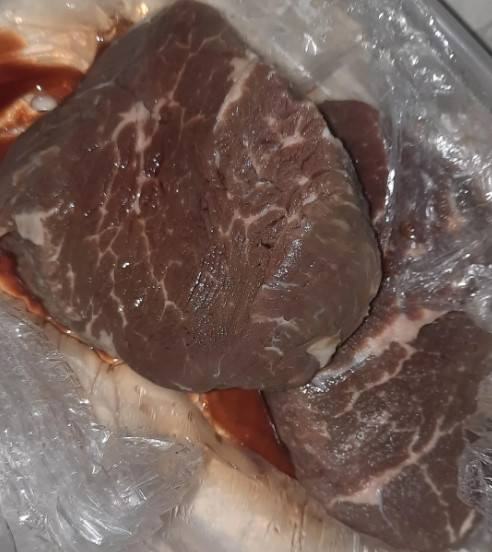Have you ever bought ground beef, only to find that it’s a little gray when you open the package? It’s a common concern, and seeing gray meat can be alarming. Most of us expect ground beef to be a vibrant red, so when it appears dull or grayish, it raises questions about its safety and freshness.
But here’s the good news: ground beef that’s gray isn’t necessarily spoiled. The color change is due to a natural process involving oxymyoglobin, a pigment in meat that reacts with oxygen. When exposed to oxygen, the outer layers of ground beef turn bright red, giving it that fresh, appealing look. However, the meat in the center of the package may appear gray or brown simply because it hasn’t been exposed to air. So, if the gray is only in the middle, your beef is likely still safe to eat.
Let’s take a closer look at why ground beef changes color and how to determine if it’s still fresh enough to cook.
Oxymyoglobin: The Red Pigment in Fresh Meat

The bright red color of ground beef is caused by oxymyoglobin, a protein that binds with oxygen to give fresh meat its reddish hue. When ground beef is packaged, the outer layer of meat is exposed to oxygen, leading to the vibrant color we expect. But as you move towards the center of the package, where oxygen is limited, the meat turns gray or brown. This doesn’t necessarily mean the meat has gone bad—it’s simply the result of a lack of oxygen exposure.
However, it’s important to note that if the outer layer of ground beef is gray or brown, that could be a sign of spoilage. The key is to understand the difference between natural color changes due to oxygen exposure and signs of deterioration.
How to Determine if Gray Ground Beef Is Safe to Eat
It’s not just the color that determines whether ground beef is still good; you need to use all your senses. Here are some tips for assessing whether gray ground beef is still safe to use:
- Smell it: The smell is often the most reliable indicator of freshness. Fresh ground beef should have a faint, meaty aroma. If it smells sour, rotten, or “off” in any way, it’s a clear sign that the meat has spoiled and should be discarded immediately.
- Feel it: Fresh ground beef should be slightly firm but still pliable. If it feels slimy or sticky, it’s best to throw it out, as this can indicate bacterial growth.
- Look for uniformity: If the entire package of ground beef is gray or brown, it’s likely past its prime and should not be consumed. When only the center is gray while the outer layers remain red, the meat is typically still fresh.
The general rule of thumb? If you have doubts about its freshness, it’s better to err on the side of caution.
When Should You Throw Out Gray Ground Beef?
While gray color alone doesn’t mean the meat is spoiled, there are situations where you should definitely toss it:
- Strong odor: If the ground beef has a pungent, unpleasant smell, it’s best to discard it.
- Slimy texture: A slimy film on the surface indicates bacterial growth and spoilage.
- Expired date: If the beef has passed its use-by date, it’s safer to throw it out, especially if you notice any other signs of spoilage.
- Gray or brown throughout: If the meat is discolored throughout the package, it’s a sign of oxidation or spoilage.
Ultimately, trusting your senses is the best way to determine whether the meat is safe. If it doesn’t look, smell, or feel right, it’s safer not to consume it.
How to Keep Ground Beef Fresh for Longer
Storing ground beef properly can extend its shelf life and maintain its red color longer. Here are some helpful tips for keeping your ground beef fresh:
- Store in the coldest part of the fridge: Keep ground beef in the back of the refrigerator where it’s coldest. It should be kept at a temperature of 40°F (4°C) or below.
- Use airtight packaging: To prevent oxidation and maintain the meat’s red color, wrap ground beef tightly in plastic wrap or place it in a sealed container.
- Freeze for long-term storage: If you’re not planning to use the beef within 1-2 days, freeze it. Ground beef can be safely frozen for up to 4 months without significant loss of quality.
- Thaw properly: When you’re ready to use frozen ground beef, thaw it in the refrigerator or use the defrost setting on your microwave. Never leave it out at room temperature, as this can promote bacterial growth.
The Importance of Cooking Ground Beef Safely

Even if your ground beef appears fresh, cooking it to the proper internal temperature is essential for food safety. Ground beef should be cooked to an internal temperature of 160°F (71°C) to kill harmful bacteria like E. coli and Salmonella.
Use a meat thermometer to ensure you’ve reached the right temperature, especially when cooking hamburgers or meatloaf. Proper cooking is one of the most effective ways to prevent foodborne illnesses, ensuring that your meals are not only delicious but also safe to eat.
Why Color Alone Can’t Be the Sole Indicator of Freshness
It’s worth repeating that the color of ground beef alone isn’t always a reliable indicator of its freshness or safety. While a bright red hue is appealing, it doesn’t necessarily mean the meat is still good. Likewise, gray ground beef isn’t always a sign of spoilage. The meat’s smell, texture, and appearance all need to be considered to make an informed decision.
Moreover, meat can turn grayish when frozen for an extended period, but that doesn’t mean it’s spoiled. This color change is due to oxidation, which is a natural process. As long as the ground beef doesn’t have any off-putting smell or slimy texture, it should still be safe to cook.
Conclusion: Is Gray Ground Beef Safe to Eat?
The sight of gray ground beef can be off-putting, but it’s not always cause for concern. If the grayness is limited to the center of the package and the outer meat is still red, it’s likely just a lack of oxygen exposure. However, if the gray extends throughout, or if there’s an unpleasant smell or slimy texture, it’s best to err on the side of caution and discard the meat.
Understanding the science behind ground beef’s color changes, combined with trusting your senses, can help you confidently decide whether the meat is still fresh. Remember, when in doubt, it’s always safer to toss it and avoid potential foodborne illnesses. Keeping an eye on color, smell, and texture will help ensure that you’re serving only the freshest and safest meals to your family.


